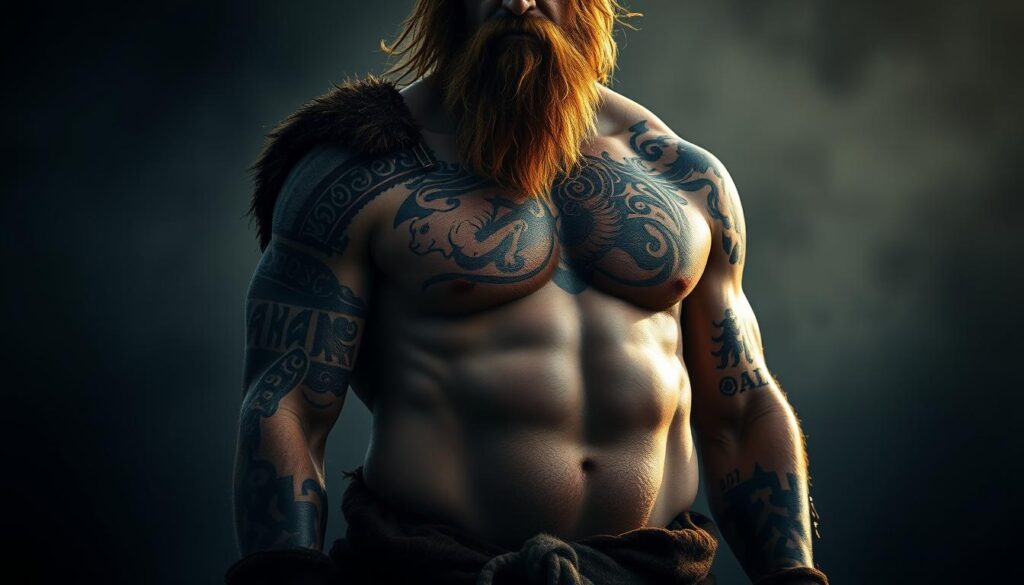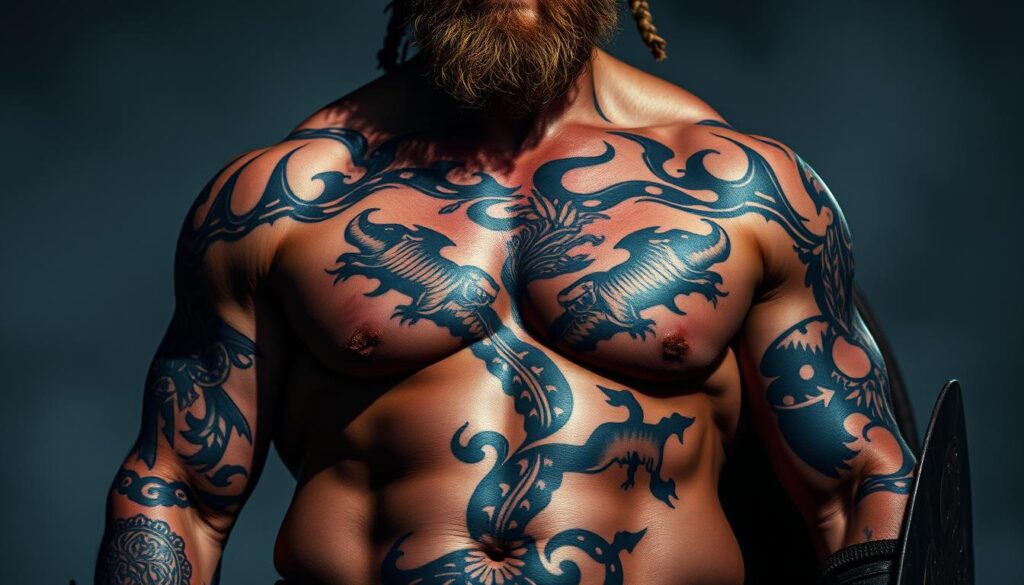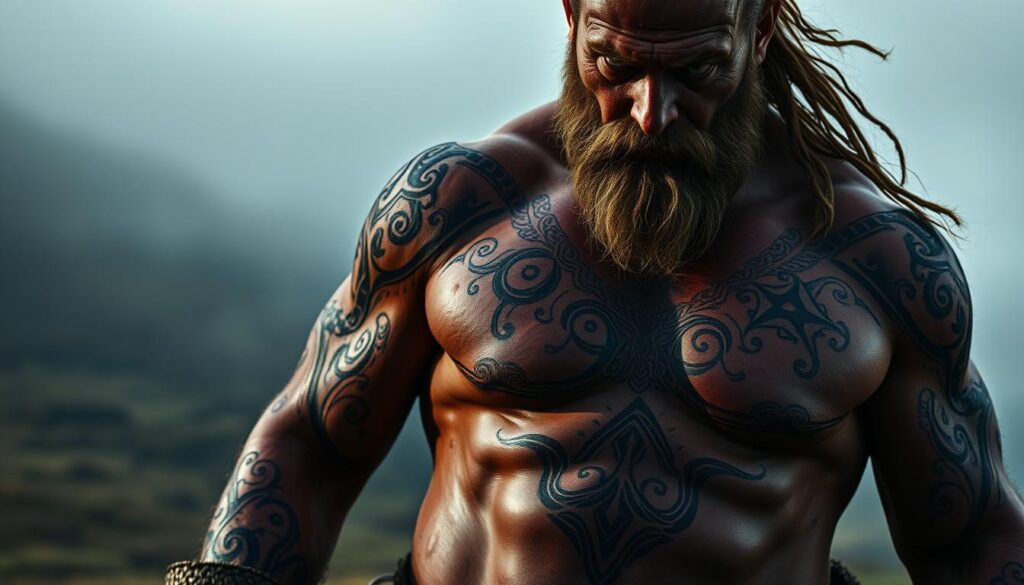
The modern image of Viking warriors is often associated with elaborate tattoos, but the historical reality is more complex.
Popular culture has perpetuated the idea of heavily tattooed Vikings, but there’s a lack of concrete evidence to support this notion. In fact, there’s no mention of tattoos in any Viking sagas, and the Vikings didn’t leave behind written records about their body art practices.
This raises an intriguing question: what do we really know about Viking body modifications? To answer this, we’ll explore historical accounts, archaeological findings, and the cultural context of the Viking Age.
Key Takeaways
- The popular image of Vikings with tattoos is not supported by historical evidence.
- Viking sagas and written records do not mention tattoos.
- Archaeological findings and cultural context may provide clues about Viking body art.
- The question of Viking tattoos involves examining sparse historical records and cultural practices.
- Understanding Viking body modifications requires a nuanced look beyond modern assumptions.
The Popular Image of Tattooed Vikings
The notion of Vikings having tattoos has become a staple in their modern portrayal, influencing various forms of media. This image of Vikings as tattooed warriors has captivated the imagination of many, reflecting a blend of historical speculation and modern aesthetic preferences.

Vikings in Modern Media
In modern media, Vikings are often depicted with elaborate tattoos, symbols, and designs that reflect their supposed warrior culture. This portrayal is evident in films, television shows, and literature, where Vikings are shown with intricate body art that signifies their status, strength, and cultural identity.
The depiction of Vikings with tattoos in media not only reflects a modern fascination with historical warrior cultures but also influences contemporary body art trends. Many people are drawn to Viking-inspired tattoos because they represent concepts of strength, courage, and destiny, rooted in Norse mythology and runes.
The Appeal of the Viking Aesthetic
The Viking aesthetic appeals to modern sensibilities because it represents freedom, strength, and a connection to ancient traditions. The rugged, untamed image of warriors with their elaborate body art represents a counterpoint to modern corporate conformity.
| Aspect | Modern Appeal | Historical Significance |
|---|---|---|
| Tattoos | Represent individuality and rebellion | Possible indicator of status or spiritual beliefs |
| Symbols and Designs | Connect wearers to concepts of strength and courage | Rooted in Norse mythology and runes |
| Warrior Culture | Reflects a broader cultural fascination with historical warrior cultures | Signifies strength, status, and cultural identity |
The popularity of Viking-inspired body art reflects a broader cultural fascination with historical warriors and the perceived values of a simpler, more authentic time. This aesthetic allows people to connect with a perceived simpler, more authentic time when personal valor and physical prowess were highly valued.
Historical Evidence: Did Vikings Have Tattoos?
To understand whether Vikings were tattooed, we must look at the historical records left by those who encountered them. The most significant accounts come from external observers who interacted with Viking populations during their travels.
Ibn Fadlan’s Account
One of the most cited historical sources regarding Viking tattoos is the account by Ahmad ibn Fadlan, an Arab traveler who encountered Vikings, known as Rus, during his journey to Eastern Europe in the early 10th century. Ibn Fadlan’s detailed description of the Vikings includes a notable mention of their physical appearance, where he observes that they were tattooed from “the nails of their toes to their necks” with dark blue or black markings. This account is significant as it provides a firsthand observation of the Vikings’ practice of tattooing.
Ibn Fadlan’s account is particularly valuable because it comes from an outside observer who was not part of the Viking culture but had direct contact with them. His description not only provides evidence of the existence of tattoos among Vikings but also gives an idea of the extent and possibly the significance of tattooing in their culture. For more insights into the historical context of tattoos, you can explore other resources, such as the discussion on what the Bible says about tattoos.

Other Historical Mentions
Beyond Ibn Fadlan’s account, there are a few other historical sources that mention or allude to the practice of tattooing among Vikings. For instance, Ibrahim Ibn Ya’qub, a Jewish merchant from Al-Andalus, visited the Danish city of Hedeby around 965 CE and noted the use of “indelible cosmetics” among both men and women, which some interpret as a reference to tattooing practices.
The absence of direct mentions of tattoos in Norse sagas and European chronicles is notable. However, Norse literature occasionally references “carving” runes on the body, which some scholars interpret as possible references to tattooing. The lack of mentions in European Christian sources is also interesting, given that monks and chroniclers often highlighted the “pagan” aspects of Viking culture. Historians debate whether this silence indicates that tattoos did not exist or were simply not considered noteworthy.
The historical evidence, though limited, suggests that tattooing was a practice among the Vikings. The accounts by external observers like Ibn Fadlan and Ibn Ya’qub provide crucial insights into this aspect of Viking culture, highlighting the complexity of interpreting historical records.
The Controversy: Tattoos vs. Body Paint
Unraveling the truth about Viking body art requires a closer examination of the historical records and cultural context. The accounts of travelers like Ibn Fadlan provide valuable insights, but they also raise questions about the nature of Viking body adornments.
Translation Challenges
Some historians have interpreted Ibn Fadlan’s descriptions to mean that the Vikings were not tattooed but had merely painted or stained their skin. However, this interpretation poses practical problems. Ibn Fadlan noted that the Vikings were well-armed at all times, yet they were engaged in trade rather than warfare. Other Arab travelers of the same era remarked on the cleanliness of the Vikings’ clothes, observing that they were “always clean.” It is challenging to understand how they could maintain clean clothing while traveling extensively if they were covered in paint.
The practical lifestyle of the Vikings, involving long sea voyages and frequent combat, makes the maintenance of temporary body paint impractical. This suggests that if they did adorn their bodies, permanent tattoos would have been more feasible.

Cultural Context and Interpretation
Understanding Viking body art necessitates considering the broader cultural context of both the Vikings and those who documented their practices. Neighboring cultures, such as the Celts and Germanic peoples, had well-documented tattooing traditions, making it plausible that the Vikings adopted similar practices.
| Cultural Practice | Viking Culture | Neighboring Cultures |
|---|---|---|
| Tattooing Traditions | Documented by travelers like Ibn Fadlan | Well-documented among Celts and Germanic peoples |
| Body Adornments | Possible use of tattoos or body paint | Tattoos and other forms of body modification |
| Spiritual Significance | Possible religious or magical purposes | Documented spiritual significance in neighboring cultures |
The spiritual significance of body markings in Norse culture could indicate that tattoos served purposes beyond mere decoration, potentially holding religious or magical significance. However, it is also crucial to consider the cultural biases of observers like Ibn Fadlan, who viewed Viking customs through their own cultural lens.
Archaeological Limitations
Uncovering the truth about Viking tattoos is complicated by the nature of the archaeological record. The Vikings left behind primarily skeletal or cremated remains, which do not preserve the soft tissue necessary for studying tattoos.

Tattooing has been a part of human culture for thousands of years, practiced across the world. The oldest known evidence of tattoos comes from “Ötzi the Iceman,” a mummified body found in the Alps, who lived over 5,500 years ago. Ötzi’s tattoos, at least 61 in number, arranged in 19 lines, provide a unique window into ancient tattooing practices.
The Problem of Preservation
The primary challenge in determining whether Vikings had tattoos lies in the preservation of human remains. Since tattoos are made on soft tissue, the lack of mummified Viking remains hinders our ability to find direct evidence. The centuries-long process of decay and the burial practices of the Vikings have contributed to this limitation.
What We Can and Cannot Know
Despite these limitations, we can infer that tattooing technology was available during the Viking Age. Cultures neighboring the Vikings practiced tattooing, and archaeological evidence shows that Vikings had the necessary tools and pigments. However, the prevalence, designs, and cultural significance of tattoos within Viking society remain uncertain. The absence of evidence is not conclusive evidence of absence; future discoveries, especially in permafrost regions, might provide more definitive evidence regarding Viking tattoos and their place in history.
By understanding these archaeological limitations, we can better appreciate the complexity of studying Viking Age practices and the need for continued exploration and research into this fascinating period of history.
Viking Body Modifications: Beyond Tattoos
Viking body modifications extended far beyond the realm of tattoos, showcasing a complex culture of personal expression. The Vikings were known for their fierce raids and battles, but they also had a rich tradition of body decoration that played a significant role in their cultural identity.

Filed Teeth: A Documented Practice
One of the most intriguing forms of Viking body modification was the practice of filing teeth. This unique custom involved altering the shape of teeth, often to create sharp points or other decorative patterns. Archaeological findings have confirmed that some Viking warriors had filed teeth, suggesting that this practice was part of their warrior culture.
The exact meaning behind filed teeth is still a topic of debate among historians. Some believe it was a symbol of status or a mark of a warrior’s ferocity in battle. Others suggest it may have been a form of spiritual or ritualistic expression.
Other Forms of Body Decoration
Beyond filed teeth and potential tattoos, the Vikings employed other forms of body decoration. Historical accounts suggest that both men and women used makeup to enhance their appearance. For example, Ibrahim Ibn Ya’qub noted that Viking men and women wore “indelible cosmetics” around their eyes, indicating that makeup was a part of their daily life.
| Body Modification | Description | Significance |
|---|---|---|
| Filed Teeth | Altering the shape of teeth for decorative or symbolic purposes | Possible symbol of status or warrior culture |
| Makeup | Using cosmetics to enhance eye appearance | Part of daily grooming and beauty practices |
| Hairstyles | Elaborate styles indicating regional origins, social status, or cultural affiliations | Expression of identity and cultural belonging |
The Vikings also paid close attention to their grooming, using combs, tweezers, and ear spoons. While body piercings were likely rare due to practical considerations during combat and seafaring, some ear jewelry has been found in Viking treasure hoards, indicating that high-status Vikings did wear jewelry in pierced ears.
The Cultural Significance of Body Art in Viking Society
Viking body art, including tattoos, played a crucial role in the spiritual and social lives of Norsemen and women during the Viking Age. The significance of body art can be understood by examining its role in their cultural and religious practices.
Status and Identity
In Viking society, body art was likely used to signify status and identity. The use of body markings, such as tattoos, may have indicated a person’s rank, occupation, or affiliation with certain groups or deities. As noted in historical accounts, symbols like Yggdrasil, the World Tree, would have carried profound cosmological significance, potentially linking the wearer to specific mythological narratives.

Spiritual and Symbolic Meanings
The spiritual significance of body art in Viking culture cannot be overstated. Norse literature references the “carving” of runes on the body for magical protection and enhancement, suggesting that body markings had deep spiritual meanings. Viking art often depicted gods with body markings, indicating that such symbols connected the wearer to divine powers or attributes. For instance, Odin was often drawn with blue facial markings representing his wisdom, while Thor was depicted with red markings symbolizing his strength.
The permanent nature of tattoos would have aligned with the Viking belief in fate and destiny, permanently marking one’s life path or spiritual commitments on the body. This practice would have been a vital part of their religious rituals, with participants temporarily or permanently marking themselves to channel the powers of specific gods.
Tattoos in Related Cultures
The Viking world was interconnected with other cultures that practiced tattooing, providing a rich context for understanding their potential tattooing practices. The Vikings had extensive contact with cultures that practiced tattooing, including Celtic, Slavic, and Baltic peoples. This exposure likely influenced their own customs and practices.
Ancient Tattooing Traditions
Tattooing was practiced in Northern Europe long before the Viking Age. The Picts, known to the Vikings, were famous for their body art, whether tattoos or paint. Germanic tribes described by Roman writers were also known to paint or tattoo their bodies, and these cultural practices may have influenced Scandinavian customs.

Neighboring Cultures’ Influence
The Rus Vikings, described by Ibn Fadlan, had been interacting with Slavic cultures for generations, potentially adopting or adapting their tattooing practices. Cultural exchange through trade, raiding, and settlement would have exposed Vikings to diverse body modification practices throughout Europe and beyond. If Vikings did practice tattooing, it likely represented a blend of native Norse traditions and influences from neighboring cultures they encountered.
| Culture | Tattooing Practice | Influence on Vikings |
|---|---|---|
| Celtic | Known to practice tattooing | Possible influence through cultural exchange |
| Slavic | Practiced tattooing, influencing Rus Vikings | Adoption or adaptation of Slavic tattooing practices |
| Germanic | Painted or tattooed bodies, described by Roman writers | Influence on Scandinavian customs |
Conclusion: The Enduring Mystery of Viking Tattoos
The enigma of Viking tattoos continues to captivate historians and enthusiasts alike. While Ibn Fadlan’s eyewitness account provides strong evidence for the presence of tattoos among some Vikings, the lack of corroborating archaeological findings leaves room for debate.
Evidence suggests that at least some Vikings, particularly those on eastern trade routes, may have had tattoos. The practice of filing teeth, a documented cultural modification, lends credibility to the possibility of tattoos. Our modern fascination with Viking tattoos reflects a deeper cultural connection to these Norse seafarers and a desire to understand their lives.
The image of the tattooed Viking, whether historically accurate or not, has become an enduring part of our cultural imagination. As we continue to explore the Viking Age, the mystery of their tattoos remains a compelling aspect of their history and legacy, making them an integral part of our shared cultural heritage.
